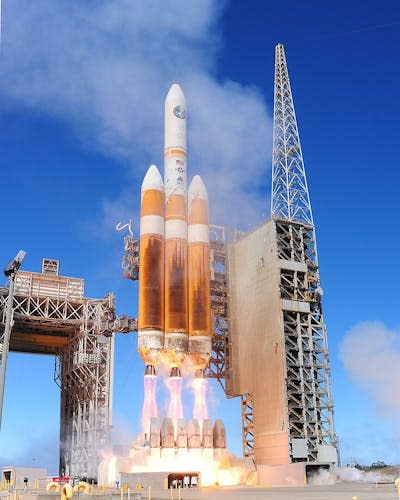Imagine driving to work on a rainy day when a distracted, careless driver suddenly crashes into your car. With a “bang” the airbag deploys faster than you can blink to save your life.
This airbag deployed quickly thanks to sodium azide, an energetic material that produces nitrogen gas during the chemical reaction to inflate your airbag. So what is an energetic material?
Energetic materials include propellants, pyrotechnics, fuels and explosives, and they are used in all kinds of environments.
Uses of energetic materials include flares, matches, solid rocket propellants, gun propellants, hot thermite welding used to combine materials, fireworks, and explosive special effects in your favorite action movie.

Energetic materials can come in many shapes and sizes, but they are usually in solid form and release a lot of energy through combustion or explosion, depending on their shape and the conditions they operate in.
I’m a mechanical engineering professor who studies energetic materials. Making energetic materials isn’t easy, but advances in 3D printing could facilitate more potential scientific applications while making customization easier.
The role of geometry
How energetic materials are made affects the shapes they come in and how they release energy over time. For example, solid rocket propellants are made similar to a cake, where a stand mixer mixes the “dough” consisting mostly of ammonium perchlorate, aluminum, and a rubbery binder before pouring it into a pan. The “cake” solidifies in the pan while baking in the oven.
Typically rocket propellants have a cylindrical shape but have a rod in the middle. The rod usually has a specific cross-sectional shape, such as a circle or star. Once the propellant solidifies, the rod is removed, leaving the core shape behind.
The shape of the core affects how the propellant burns, which can affect the thrust of the engine in which it is used. By simply changing the central shape of the propellant, you can make the engine accelerate, slow down, or maintain speed over time.
But this traditional “cake baking” process limits the shapes you can make. You need to be able to remove the rod after the propellant solidifies, so if the shape of the rod is too complex it can break the propellant, causing it to burn unevenly.
Designing propellant shapes that allow rockets to go faster or fly farther is an active area of research, but engineers need new manufacturing methods to create these increasingly complex designs.
3D printing saves
3D printing has revolutionized manufacturing in several ways, and researchers like me are trying to understand how it can improve the performance of energetic materials. 3D printing uses a printer to stack material layer by layer to create an object.
3D printing allows you to create custom shapes, print multiple types of materials in one piece, and save money and materials.
However, 3D printing of energetic materials is quite difficult for various reasons. Some energetic materials are very viscous, which means it is very difficult to squeeze the mixture through a tube with a small nozzle. Imagine squeezing the clay out of a small syringe; The material is too thick to pass through the small hole easily.
Additionally, energetic materials can be dangerous if used incorrectly. They can ignite if exposed to too much heat or static electric shock during the manufacturing process or during storage.
latest progress
Despite this, researchers have made much progress over the past decade to overcome some of these challenges. For example, scientists are using 3D-printed reactive inks on electronics so that they can self-destruct if they fall into the wrong hands.
In theory, by strategically 3D printing these inks onto old satellites or the aging International Space Station, you could break these orbiting devices into pieces small enough to burn up in the atmosphere before hitting the ground.
Many researchers are investigating 3D printed gun propellants. Changing the shape of gun propellants could allow bullets to fly farther.
Others have sought to use 3D printing to reduce the environmental impact of weapon propellants and propellants, which require harsh solvents to manufacture. These solvents are unsafe, difficult to dispose of, and can harm the environment and human health.
I showed that it is possible to 3D print solid rocket fuels with properties similar to conventionally produced fuels. With this research, we now have the opportunity to explore the new field of how propellants made of more than one material burn.
For example, instead of using rods to create a cross-sectional shape in the propellant, you can 3D print a highly reactive material that you can attach to the center. Instead of removing the material in the middle, you can burn it so quickly that a core shape is left behind. The reactive material will also add energy to the propellant. This will eliminate the need to use and remove a rod to create a central core.
While much of this research is in its early stages, companies like X-Bow are 3D printing propellants and conducting successful flight tests with these engines.
Finally, several researchers have studied how 3D printed explosives explode. Explosives react differently when pressed into a grid-shaped cage or when their pores are filled with air or water. This process produces a safer, “switchable” explosive that does not react unless it is in a certain environment.
3D printing of energetic materials is still a new field. Scientists have a long way to go before we fully understand how 3D printing affects their safety and performance. But every day, scientists like me are finding new ways to use 3D-printed energies to serve crucial and sometimes life-saving purposes.
This article is republished from The Conversation, an independent, nonprofit news organization providing facts and authoritative analysis to help you understand our complex world. Written by Monique McClain Purdue University
Read more:
Monique McClain receives funding from the Air Force Office of Scientific Research (AFOSR), the Army Research Office (ARO), and the National Aeronautics and Space Administration (NASA).